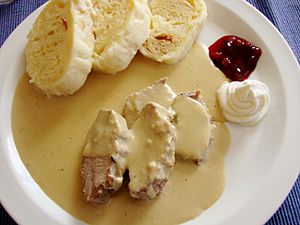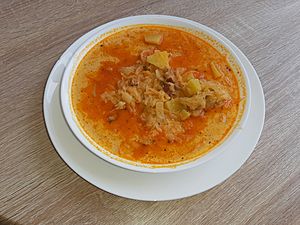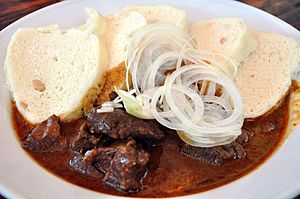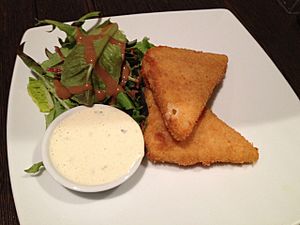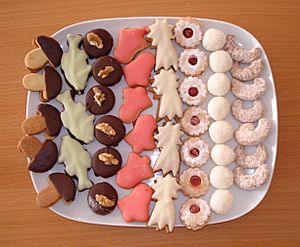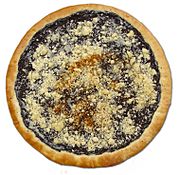Czech cuisine facts for kids

Czech cuisine (called česká kuchyně in Czech) is the traditional food of the Czech Republic. It has been shaped by the foods of nearby countries. Many popular cakes and pastries from Central Europe actually started in the Czech lands. Today, Czech food uses more meat than in the past. This is because there's more meat available from farms. Long ago, people usually ate meat only once a week, often on weekends.
A typical Czech meal usually has two or more parts. First, there's usually a soup. Then comes the main dish. After that, there might be a dessert or a fruit compote (kompot). Czech food often features thick soups and many kinds of sauces. These sauces are made from cooked vegetables and meats, sometimes with cream. Baked meats with natural gravies are also popular. People often enjoy these dishes with Pilsner beer, which Czechs drink more of than anyone else in the world! Czech cuisine is also famous for its sweet main dishes and desserts, which is quite special in Europe.
Contents
History of Czech Food
In the 1800s, a Czech cookbook called Pražská kuchařka by Karolína Vávrová showed how French cooking influenced Czech meals. Meals often started with soup, then fish, then meat, and finally sweets. However, flour-based sweets like baked puddings, strudels, and doughnuts could be served before or after the main meat dish. Creamy desserts, cakes, and ice cream were always served after the meat.
What Are Common Side Dishes?
Dumplings (knedlíky) are a very important part of Czech meals. They are steamed and sliced like bread. Dumplings can be made from wheat or potatoes. Sometimes, they are even made from a mix of wheat flour and old bread pieces. Smaller Czech dumplings are usually potato-based. If there are leftovers, sliced dumplings are sometimes fried with eggs. Potato dumplings are often filled with smoked meat and served with spinach or sauerkraut. Fried onion and cooked cabbage are also common sides.
Many other side dishes are popular, including noodles and boiled rice. Potatoes are often boiled with salt, caraway seeds, and butter. Mashed potatoes are also common. New potatoes are sometimes boiled with their skins on. Because of influences from other countries, fried potatoes like French fries and croquettes are also found in restaurants.
Grains like buckwheat, pearl barley, and millet are not often served in restaurants. People usually cook these healthier options at home. Pasta is common, either baked, boiled, or mixed with other ingredients. It can also be served as a salad. Pasta comes in different shapes and flavors, showing influences from Italian and Asian cooking. Gluten-free pasta, made from corn flour or potatoes, is also available.
Breads and Pastries
Bread (chléb or chleba) is usually sourdough, made from rye and wheat. It's flavored with salt, caraway seeds, onion, garlic, or other seeds. Bread is eaten with soups and main dishes. It's also used to make Czech croutons and topinky. Topinky are slices of bread fried on both sides and rubbed with garlic.
For breakfast, common breads include rolls (rohlík), buns (žemle), and braided buns (houska). These are often topped with poppy seeds and salt. A sweet roll called loupák is shaped like a crescent. It's made from sweet dough with milk, brushed with egg, and sprinkled with poppy seeds before baking.
Popular Czech Soups
Soup (polévka) is very important in Czech cooking. In restaurants, you'll often find beef, chicken, or vegetable broths with noodles. These might also have liver or nutmeg dumplings. Garlic soup (česnečka) with croutons is another favorite, sometimes served with sausage or cheese. Cabbage soup (zelňačka), made from sauerkraut, is also common. Kyselica is a special cabbage soup from the Wallachia region, with sour cream, bacon, potatoes, eggs, and sausage.
At home, people often cook pea (hrachovka), bean, and lentil soups. Goulash soup (gulášovka) and dršťková are made from beef or pork tripe (stomach lining) cut into small pieces. You can also use oyster mushrooms instead of meat. Potato soup (bramboračka) is made with potatoes, onion, carrots, and celery root. It's spiced with caraway seeds, garlic, and marjoram. Fish soup, made with carp, is a traditional Christmas dish.
Other common Czech soups include mushroom soup, tomato soup, vegetable soup, and onion soup (cibulačka). Kulajda is a creamy, thick soup from South Bohemia. It has water, cream, spices, mushrooms, an egg (often a quail's egg), dill, and potatoes. Its main ingredient is mushrooms, which give it a special smell. Kyselo is a regional soup made from rye sourdough, mushrooms, caraway, and fried onion.
Meat Dishes in Czech Cuisine
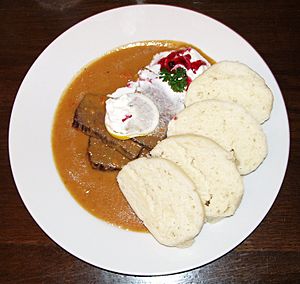
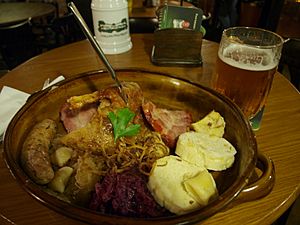
Traditional Czech dishes often use meat from animals raised nearby. Pork is the most common meat, making up over half of all meat eaten. Beef, veal, and chicken are also popular. Pigs are often raised in the countryside because pork is ready to eat faster than beef.
You might find special pork products like jitrnice, which is pork meat and organs cut into small pieces and put into a casing. Klobása (like Kielbasa) is a smoked sausage made from minced meat. It's spicy and lasts a long time. Jelito is a pork sausage that contains pork blood and barley. Tlačenka is a meat product with small pieces of meat in a jelly, often served with onion, vinegar, and bread. Ovar is a simple dish of fatty pork meat (like from the head or knuckle) boiled in salted water. Pork cracklings (škvarky) and bacon (slanina) are also eaten.
In restaurants, you can find:
- Guláš (Goulash): This is a stew usually made from beef, pork, or game meat with onions and spices. It's often served with knedlík (dumplings) or bread. Czech guláš is different from Hungarian goulash, which is more like a soup.
- Roast pork with dumplings and cabbage (pečené vepřové s knedlíky a se zelím, or vepřo-knedlo-zelo for short): This is often seen as the most typical Czech dish. It includes cabbage that can be cooked or pickled, ranging from sour to sweet.
- Marinated sirloin (svíčková na smetaně): This dish uses braised beef, often larded (meaning strips of fat are put into the meat). It comes with a thick sauce made from carrots, parsley root, celeriac, and sometimes cream. It's usually served with knedlíky, whipped cream, cranberry compote, and a slice of lemon.
- Schnitzel (řízek): This is a Czech meat dish. It's usually thin slices of veal, pork, or chicken. The meat is covered in a "triplecoat" (trojobal) of flour, whisked egg, and breadcrumbs, then fried. Řízek is served with potato side dishes. This triplecoat is also used at Christmas to fry carp or trout.
- Smoked meat (uzené): Served with potato dumplings, fried onion, and cooked spinach.
- Beef with tomato sauce (rajská omáčka): This is served with dumplings. Dill sauce (koprová omáčka) is also common.
- Rabbit is often raised in the countryside. Hare and other wild game are also served. Mutton, lamb, boar, and deer are not as common.
Common poultry dishes include:
- Goose, duck, turkey, and chicken. Other game birds like pheasant are less common.
- Roast duck (pečená kachna): Served with bread or potato dumplings and braised red cabbage.
- Chicken in paprika sauce (kuře na paprice): Chicken stewed with onion, paprika, and cream.
- Fish, mostly trout and carp, are commonly eaten at Christmas. Other fish like sardines, salmon, and tuna are imported.
Other Interesting Dishes
- Mushrooms are often used in Czech cooking because many types grow in the forests. Czechs love to pick mushrooms! You can find common mushrooms (žampiony), oyster mushrooms (hlívy), and dried forest mushrooms in shops. Smaženice are shallow-fried mushrooms with onion and spices. Mushroom Jacob (Houbový Kuba) is a dish made from cooked barley, mixed with cooked mushrooms, fried onion, garlic, and pepper, then baked. It's served at Christmas.
- Fried cheese (Smažený sýr or smažák): This is usually a thick slice of Edam cheese (or Hermelín) coated in flour, egg, and bread crumbs, then fried. It's served with tartar sauce and potatoes or french fries.
- Homemade noodles with ground poppy seeds (nudle s mákem): These are served with powdered sugar and melted butter. A similar dish is potato buns with poppy seeds (bramborové šišky s mákem).
- Pancakes (palačinky): These are common, either plate-sized or palm-sized.
- Common vegetables include carrots, celery, parsley, turnip, cauliflower, lettuce, onion, garlic, and cabbage. In gardens, you might find tomatoes, bell peppers, courgettes, pumpkins, and potatoes.
- Peas and lentils are common. They are served as soup or as a cooked mash with pickled cucumber and fried onion.
- Žemlovka: A baked dish with layers of sliced rolls or buns, sliced apples, and milk or eggs. It's served with cinnamon and raisins.
- Štrúdl or závin (Strudel): Can be sweet with apples, raisins, walnuts, or cherry. It can also be savory with cabbage, spinach, cheese, or meat.
- Semolina porridge (krupicová kaše): Served with sugar, honey, cinnamon, or cocoa with butter on top. Sliced apples or apricots can be added.
- Stuffed bell peppers (plněné papriky): Stuffed with meat or rice and vegetables.
- Lečo: A stew made from peppers, onions, tomatoes, and spices.
- Spaghetti (špagety): An Italian influence that is becoming popular.
- Eggs are often used. Scrambled eggs (míchaná vajíčka) are common. Fried eggs (volské oko, meaning "ox eye") are often served with bread or potatoes and spinach. Boiled eggs are also popular.
- Dairy products are also important. Edam cheese (eidam) is a common type. Niva is a Czech blue cheese. Nakládaný hermelín, or pickled cheese, is a soft cheese similar to Camembert aged in olive oil and spices. It's a common pub food, served with bread and fresh vegetables. Sour cream is used in many sauces.
Quick Snacks
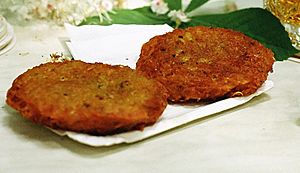
- Bramboráky (Potato pancakes): These are fried pancakes made from grated raw potato, flour, and spices like marjoram, salt, pepper, and garlic. They are similar to rösti. Smaller ones are often eaten as a side dish.
- Utopenci (literally "drowned men"): These are spicy pickled sausages (špekáčky) in a sweet-sour vinegar marinade with black pepper, bay leaf, onion, and chili peppers. You can often find them in Czech pubs.
- Nakládaný hermelín: A soft cheese, like brie, marinated with peppers and onions in oil. It's a popular pub snack.
- Beer cheese (pivní sýr): A soft cheese, usually mixed with raw onions and mustard, spread onto toasted bread. Also a pub food.
- Open sandwiches (obložené chlebíčky): These are not made from regular Czech bread. They use a special sliced pastry called veka. They are topped with things like mayonnaise, ham, egg, fish, or salads. They are often decorated with fresh or pickled cucumber, tomato, or parsley. Jednohubky are smaller versions, eaten in one bite.
- Olomoucké tvarůžky or syrečky: An aged cheese with a strong smell. It's made in Loštice, a town in Moravia. This cheese has been made since the 15th century. It can be fried, marinated, or added to bramboráky.
- Dried apple chips (křížaly) and dried banana chips are common.
- Potato, beet, and celery chips are popular snacks.
- Roasted peanuts are common.
- The "Czech hot dog" (párek v rohlíku): This is a street food. It's a boiled or steamed sausage dipped in mustard or ketchup, served inside a roll with a hole made in it (not a sliced bun like a regular hot dog). It's influenced by German food.
- Langoše (fried bread): Influenced by Hungarian food. They are usually served with garlic, Edam cheese, and ketchup.
Sweet Treats
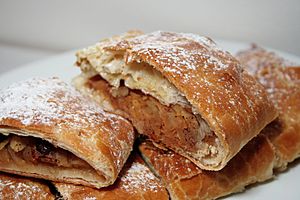
Czech coffeehouses are famous for their strong coffee, sweet pastries, and famous visitors like Franz Kafka and Albert Einstein. Strudel is served warm or cold in almost every coffee shop, often topped with ice cream or powdered sugar. Apple strudel is the most common kind.
Sweets filled with fruit, poppy seeds, and quark (a type of soft cheese) are very popular. They come in many forms, like cakes, koláče (pies), tarts, and fruit dumplings (ovocné knedlíky). Making koláče is a lot of work, so they are usually made for special events like celebrations or weddings. Common fillings include poppy seeds, apricots (meruňkové knedlíky), and prunes.
Dumplings can also be made with potatoes in the dough. While the fruits, jams, and cheeses used vary, plums (švestkové knedlíky), apricots, or strawberries (jahodové knedlíky) are common. Boiled dumplings are often topped with butter, poppy seeds, or grated cheese, and a sweetener. Czech crepes called palačinky are also filled with fruit or jam. Traditional Czech sponge cake (bublanina), often eaten for breakfast, is made with cream, eggs, sugar, and seasonal fruits, especially whole cherries.
- Buchty: A yeast pastry similar to koláče. The filling is wrapped inside pieces of dough and baked, so it's not visible from the outside.
- Sweet dumplings with custard sauce (buchtičky se šodó): Small pieces of yeast pastry covered with a cream made from egg yolks and wine (nowadays often vanilla pudding).
- Braided bread (vánočka) and buns (mazanec): Prepared for Christmas, along with many kinds of biscuits and Christmas sweets (vánoční cukroví). Vánočka is similar to Jewish Challah.
- Easter Lamb (Velikonoční beránek): Prepared for Easter. The dough is made from eggs, sugar, and flour, often with lemon. It's baked in a lamb-shaped mold and can be decorated.
- Bábovka: A round cake, 10–15 cm high, made in a mold. The dough is similar to Easter Lamb dough, often with cocoa dough in the middle. It's often served with coffee.
- Lívance: Smaller pancakes made with yeast in the batter. They are eaten with jam or warm forest fruits.
- Perník: Can be like gingerbread, but without ginger and with added honey. Gingerbread cookies are decorated with shapes, like hearts or even whole villages. It can also be a cake with cinnamon and honey.
- Roláda: A sponge cake roll filled with jam.
- Litá bublanina: A pancake-like batter poured onto a baking sheet. Pieces of fruit (like apples or cherries) are spread on it and sprinkled with sugar.
- Makovec: A sponge cake with ground poppy seeds.
- Mrkvanec: A sponge cake with grated carrots. Mrkvánky are small turnovers filled with plum or pear jam, with grated carrot added to the dough.
- Most sweets, except for koláče, Christmas sweets, and Easter Lamb, are eaten with tea or coffee in the late afternoon, not right after a main meal.
- Míša: A frozen treat made from curd cheese. It's popular with children and has been made since 1961.
What Do Czechs Drink?
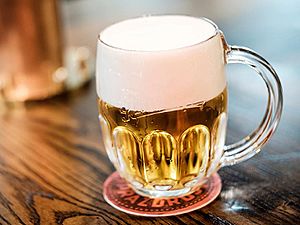
The Czech Republic drinks more beer per person than any other country in the world! The most common type of beer, Pilsner, actually started here. Besides beer, Czechs also make wine, mostly in the region of Moravia. They also have unique liquors like Becherovka. Czech Slivovitz and other fruit brandies (pálenka) are traditionally made in the country and are considered national drinks.
More recently, new drinks have become popular. One is Tuzemák, traditionally called "Czech rum", made from potatoes or sugar beets. A mixed drink called Beton ("concrete") is made from Becherovka and tonic water. Another popular mix is Fernet Stock with tonic, called Bavorák or Bavorské pivo (meaning "Bavarian beer"). Kofola is a non-alcoholic Czech soft drink that looks and tastes a bit like Coca-Cola, but it's not as sweet. Kofola was created in communist Czechoslovakia as a replacement for Coca-Cola, which wasn't imported. It became so popular that it's still made today!
See also
 In Spanish: Gastronomía de la República Checa para niños
In Spanish: Gastronomía de la República Checa para niños


